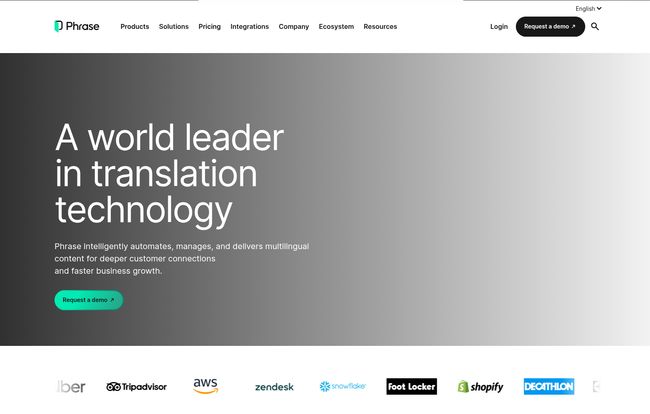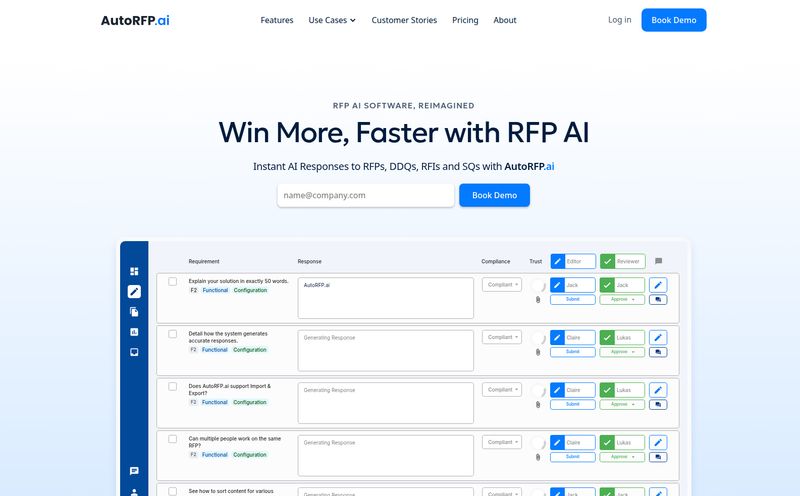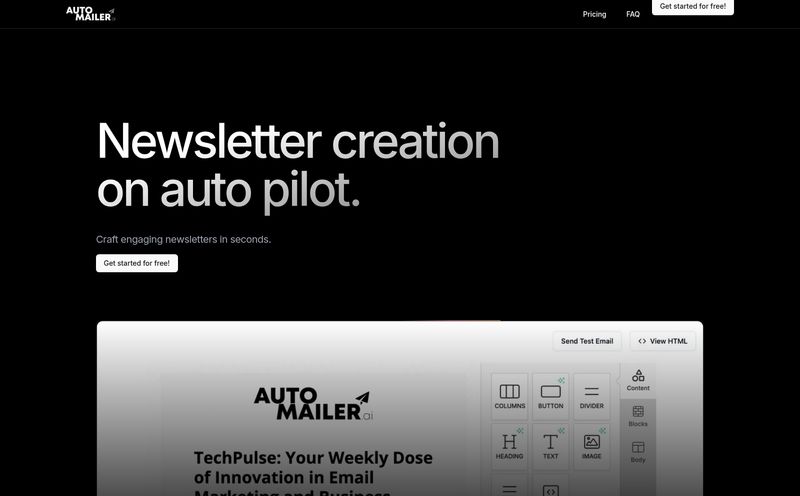I'm going to tell you a story. A few years back, I was managing a global content launch for a SaaS client. We were translating their website into five new languages. The process was, to put it mildly, a dumpster fire. We had translators in different time zones, designers who didn’t speak the languages, and a project manager whose main tool was a monstrous Excel spreadsheet. I still have nightmares about files named translation_final_v3_John's_edit_USE_THIS_ONE.xlsx.
We’ve all been there, right? Juggling a dozen different tools, endless email chains, and the constant fear that a bad translation will turn your clever marketing copy into a cringeworthy meme. It’s the messy, unglamorous side of global expansion.
That’s why when a tool comes along promising to be a single, intelligent hub for all of it, my ears perk up. I’m talking about Phrase. You might have known it in its past life as Memsource, which was already a pretty big name in the translation management space. Now, it's been rebooted and expanded into something much bigger. But is it just another shiny object, or is it the real deal?

Visit Phrase Localization Platform
So, What Exactly is Phrase?
Let's get one thing straight: calling Phrase just a "translation tool" is like calling a smartphone just a "phone." It's technically true, but misses the entire point. Phrase positions itself as a complete localization suite. Think of it less as a simple dictionary and more like the air traffic control tower for your entire global content strategy.
It’s a cloud-based platform designed to manage the whole chaotic process of making your content—be it a website, an app, or a marketing campaign—feel native in any language. It pulls together AI-powered machine translation, a robust translation management system (TMS), and a ton of integrations to create a unified workflow. The goal is to stop the madness of manual file transfers and lost-in-translation moments.
The Features That Actually Matter
A feature list is just a list. What I care about is how those features solve the real-world headaches I face every day. Here’s my breakdown of what makes Phrase stand out.
A True Central Hub for Localization
The core promise of Phrase is to be your single source of truth. Instead of having design files in Figma, support articles in Zendesk, and website copy in a CMS, Phrase connects to all of them. It acts as a central repository where all your source content and its translations live. This eliminates the frantic searching for the “latest version” because there’s only one version—the one inside Phrase. For anyone who has ever accidentally published an outdated translation, you know how huge this is.
AI That's Genuinely Smart, Not Just a Buzzword
Everyone slaps “AI-powered” on their products these days, but here it feels earned. The AI in Phrase does more than just spit out a machine translation. Its real power is in what they call Intelligent Automation. For instance, it can analyze incoming text and decide what doesn't need to go to a human translator. Repetitive strings, previously translated phrases (from your translation memory), or low-impact text can be handled automatically. This is a game-changer for budgets and timelines. You're no longer paying a professional linguist to translate “Click here” for the thousandth time.
Integrations Galore (This is a Big One)
This, for me, is where the magic happens. Phrase boasts over 50 integrations with the tools your team is already using. We're talking about direct connections to:
- CMSs: Contentful, WordPress, Drupal
- Code Repositories: GitHub, GitLab, Bitbucket
- Design Tools: Figma, Sketch
- Marketing & Support: Salesforce, Zendesk, Marketo, Shopify
This means your developers can push new code, and the text strings are automatically sent to Phrase for translation. Your designers can finalize a layout in Figma, and the copy is pulled for localization without a single copy-paste. It creates a continuous localization loop that just… works. No more manually exporting and importing files. Hallelujah.
Actionable Analytics, Not Just Vanity Metrics
How much are you spending on Spanish translations this quarter? Is translation quality improving? Which content is taking the longest to turn around? Most localization workflows can’t answer these questions. Phrase has a built-in analytics dashboard that gives you real, actionable data on costs, quality, and project progress. It helps you justify your localization budget and prove its ROI, which is something every marketer and project manager needs to do.
Let's Talk Money: A Look at Phrase Pricing
Alright, let's get to the question on everyone's mind: what's this going to cost me? Phrase isn’t shy about its pricing, and it’s definitely positioned as a premium product. It’s not for the casual hobbyist translating a personal blog.
They have a few main tiers, primarily aimed at businesses. Here’s a quick overview based on their current pricing page (prices in Euros, billed annually):
| Plan | Price (per month, billed annually) | Who It's For |
|---|---|---|
| Starter | €125 | Small teams or startups just getting started with web & software localization. |
| Team | €995 | Growing businesses that need more integrations (like Figma & Slack) and advanced features. |
| Business | Custom | Larger organizations needing SSO, advanced analytics, and more robust integrations. |
| Enterprise | Custom | Global corporations requiring the highest level of security, support, and customization. |
Now, seeing a price tag close to €1,000 a month for the Team plan might cause some sticker shock. But here’s how I think about it: how much does your current, inefficient process cost? Think about the man-hours spent managing spreadsheets, fixing errors, and the opportunity cost of a slow time-to-market. When you frame it that way, the price for a platform that automates all that away starts to look a lot more reasonable. You’re not just buying software; you’re buying speed and sanity.
The Not-So-Perfect Bits (My Honest Take)
No tool is perfect, and I wouldn’t be giving you an honest review if I didn’t point out a few potential drawbacks.
First, the learning curve is real. A platform this powerful has a lot of features, and it's not something you’ll master in an afternoon. You and your team will need to invest some time in onboarding to really get the most out of it. It’s a professional suite, and it expects a professional commitment.
Second, its heavy reliance on integrations is both a strength and a potential weakness. While the integrations are fantastic, you are dependent on them. If a third-party service like Figma or Salesforce decides to overhaul its API, it could temporarily disrupt your workflow. It's a risk with any connected ecosystem, but something to be aware off.
Frequently Asked Questions About Phrase
What's the difference between Phrase TMS and Phrase Strings?
Think of them as two parts of the same brain. Phrase TMS is the core translation management system for traditional documents and websites, where translators work. Phrase Strings is specifically designed for software localization—managing the little bits of text (strings) found in apps, games, and software UIs. The platform integrates them both.
Can I bring my own translators or do I have to use theirs?
Yes, you can absolutely invite your own freelance translators or localization agency to work within the platform. Phrase is vendor-agnostic, giving you the flexibility to work with your preferred linguistic partners.
Is Phrase secure for sensitive or confidential content?
This is a big focus for them. They are compliant with major standards like ISO 27001 and GDPR, and they run on secure infrastructure like AWS. For most businesses, including those in finance and healthcare, their security is top-notch.
Does Phrase AI replace the need for human translators?
No, and it's not designed to. It’s meant to augment human translators, not replace them. The AI handles the repetitive, low-value work, freeing up human linguists to focus on creative, nuanced, and high-impact content where their skills are most needed. It’s about making the entire process smarter, not just automated.
What happens during the 14-day free trial?
The trial gives you access to the full features of the chosen plan, allowing you to test the workflows, set up an integration, and run a pilot project. It's a no-commitment way to see if the platform actually fits your team's needs before you spend a dime.
Final Thoughts: Is Phrase the Real Deal?
After spending considerable time looking into Phrase, I have to say, I'm pretty impressed. It’s one of the most comprehensive and well-thought-out localization platforms on the market today. It successfully tackles the biggest pain points of global content management: decentralization, manual work, and lack of oversight.
Is it for everyone? Probably not. If you’re a small business translating a few landing pages a year, it might be overkill. But if you’re a growing company serious about global expansion, a SaaS business with continuous development cycles, or a marketing team trying to run coordinated global campaigns, then Phrase could be a transformative investment.
It’s a professional-grade tool that brings order to chaos. And for anyone who’s ever been lost in the spreadsheet wilderness, that’s a promise worth its weight in gold.



